Heavy equipment durability testing: Living on the edge!
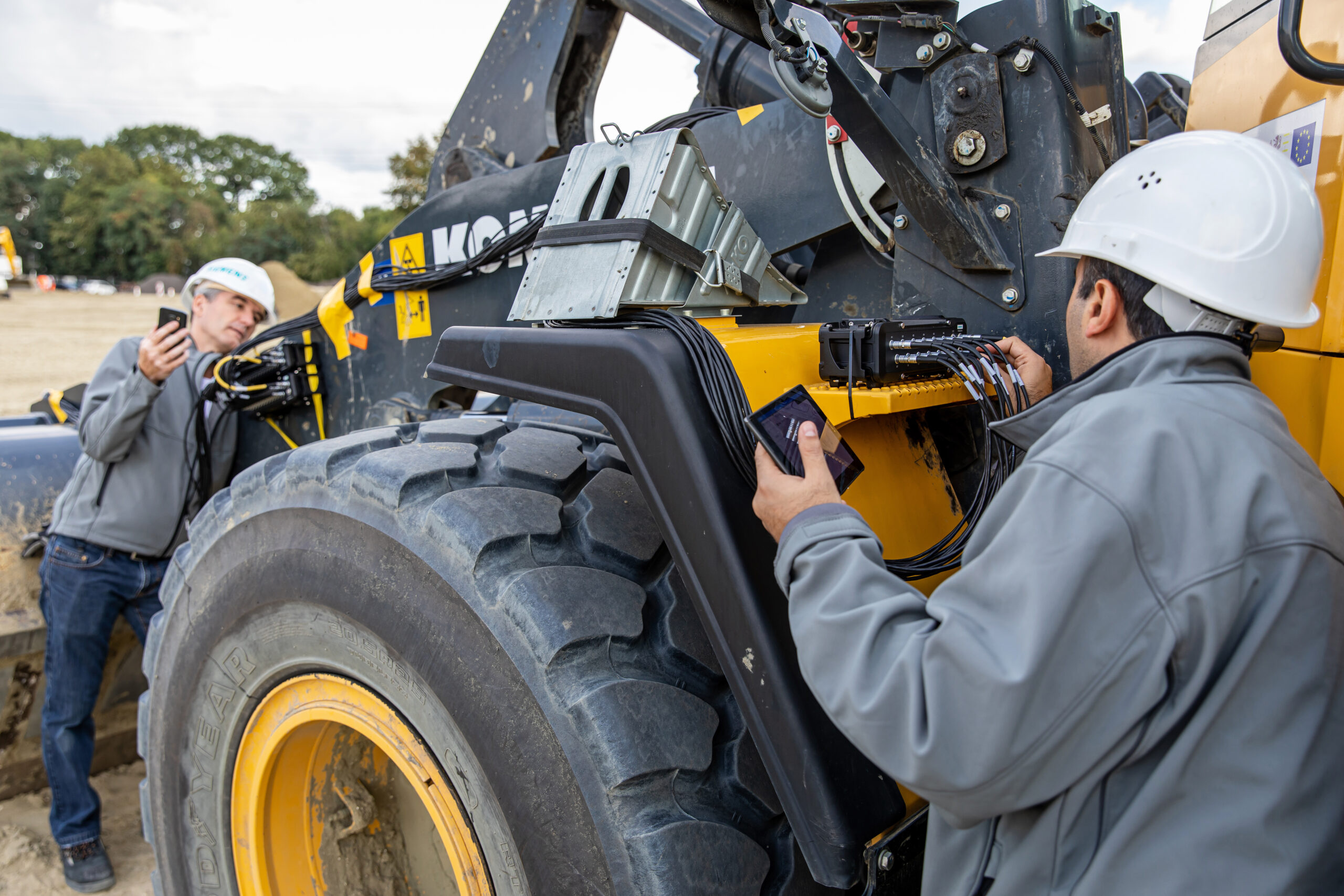
Imagine this scenario. You want to measure real-life loads impacting the durability lifetime of an agricultural machine. You’re on a field, in the middle of nowhere, which feels like thousands of kilometers away from your home. You have only one shot to measure as you have waited a whole year to have crops and the field itself turned into the current situation. All the sensors you need are implemented, such as strain gauges, displacement sensors, force cells, accelerometers, with all required cables. So, the instrumentation is completed after all. You start your measurement and after 1 hour of data acquisition, you notice some strange signals from all of your channels. You stop the measurement to check everything. Guess what? The measurement system is broken due to the high loads coming to the hardware from the extreme field conditions. And of course, Murphy says hi to you!
Has your heart also dropped? I know all the test engineers are grimacing just like I am … I hope you still have 1 more year to re-do the measurement… Never stop dreaming, there is always a better world!
Let’s talk about positive things. I’m going to tell you about a full durability testing campaign I performed very recently on a wheel loader. I hope I can make you all delete that image from your mind by giving you some hints to improve your daily durability testing assignments.
I started with the following questions in mind before starting my durability testing activities:
- What exactly should I measure?
- How can I increase the efficiency of such a time-consuming task?
- What data do I need to perform my durability lifetime assessment?
- How can I reshape the data I measured to replicate the same conditions later on?
Then I decided to use our Simcenter SCADAS RS hardware and Simcenter Testlab software to perform everything I need. Check-out the step-by-step approach I took for a heavy equipment durability testing
- Measure anything and go beyond
- Faster and reliable hardware
- Flexible software operations
- Innovative load data analysis
- Build accelerated test scenarios
1. Measure anything and go beyond
For heavy equipment durability testing, we mainly measure a wide range of quantities in order to understand the real customer usage and its reflection on the machine we test.

These quantities require different types of sensors and conditioning on the data acquisition hardware side. In this manner, Simcenter SCADAS RS hardware would be very suitable with its modular system architecture to cover any analog or digital channel to measure.
Simcenter SCADAS RS mainly offers 3 different types of units:
- Data recording unit,
- Signal conditioning units,
- Power supply unit
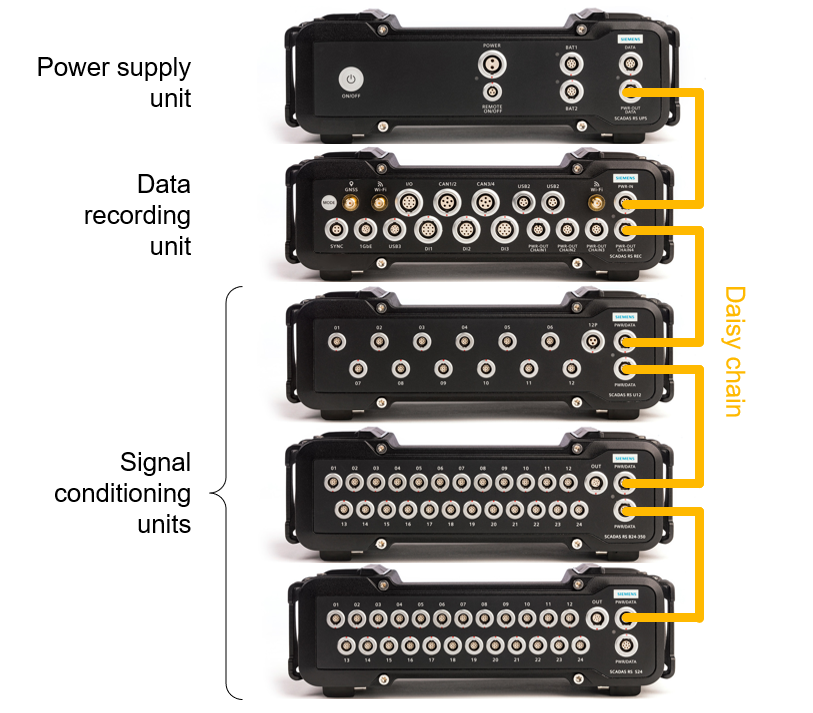
The connection through these different units can be provided by a single daisy chain cable which is for digital data transfer, data synchronization and power transfer. Let’s go through all these units one by one.
1-a) Universal signal conditioning unit: U12
For some test engineers, covering a wide range of different sensors with standardized measurement system plays a very critical role. With this way, same setup could be grabbed for any measurement independent from the analogue sensor type they measure.
We developed U12 unit in order to fulfill this requirement which enables 12 channels per unit.
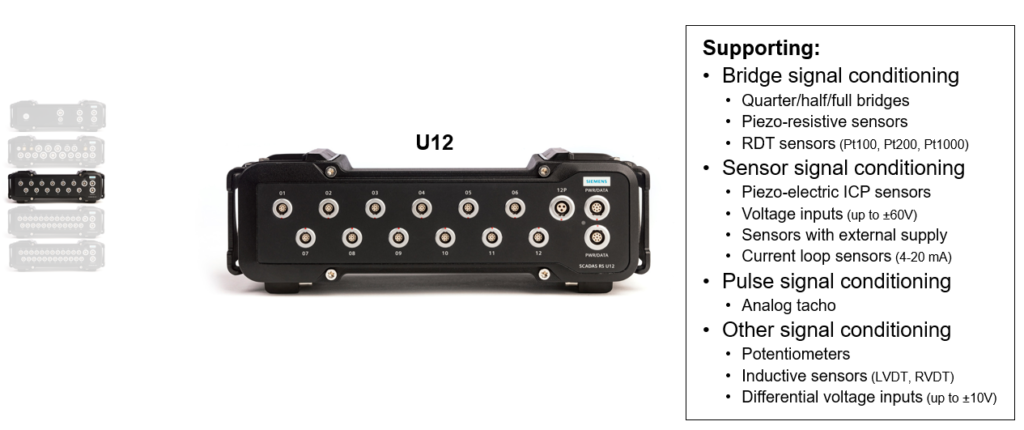
1-b) High channel density units: B24 and S24
For some test engineers, high channel measurements are their usual works, and they need efficient hardware which can easily cover hundreds or even thousands of channels.
So, we developed B24 and S24 units in order to allow high channel density where each unit enables 24 channels. B out of B24 stands for ‘bridge’, while S out of S24 stands for ‘sensor’.
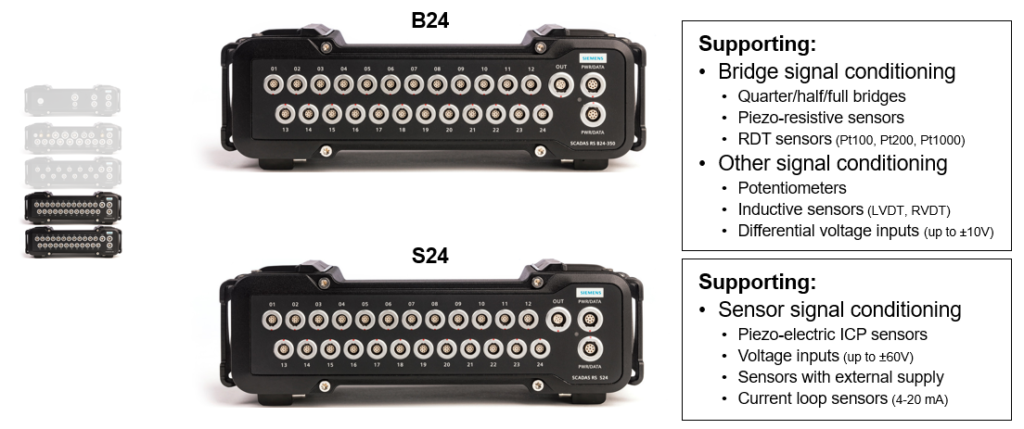
You might also notice that if you combine B24 with S24 units, you will reach the same sensor flexibility level on a higher channel configuration.
1-c) Data recording unit: REC
On top of all the conditioning units, we also have a REC unit for onboard storage and digital data acquisition. I should also indicate that digital data acquisition is quite crucial across the heavy equipment industry.

Besides the fact that REC is the brain of the system, it also enables digital data acquisition with different options. Each REC unit supports up to 4 CAN devices, 4 digital IO, 3 encoders (9 pulses), and 2 USB2 devices. With onboard storage of up to 240 GB and an embedded GPS/GNSS receiver, it also enables stand-alone recording.
1-d) Uninterruptable power supply: UPS
Simcenter SCADAS RS will make sure the system always gets an uninterruptible, smart, and secure power supply, thanks to a dedicated unit, called the Simcenter SCADAS RS UPS unit. The UPS unit has an integrated power and health management on-board, making sure all units and sensors always have a stable power supply.

The UPS unit also enables smart powering. When using this feature, the system will start up automatically from the moment the test engineer or driver starts the engine of the vehicle for example. In case the external power supply fails, it will shut down safely, preventing the measured data becomes corrupted or even is lost.
1-e) Measure the unmeasurable
In the context of heavy equipment durability testing, it’s not always easy to physically measure from every single location on the machine due to limited access and high sensor cost. So, the question is ‘Can we use simulation models while testing to create virtual channels?’. It’s all about model accuracy – as soon as we have correlated models, this should be feasible. But managing simulation data and physical testing data together also requires some effort.
Simcenter Testlab software enables you to bring simulation data next to test data such that you can integrate and cooperate with each other. In this way, it’s very straightforward to compare tests and simulation, correlate them by optimizing the model parameters, and even integrate them to extend physical measurement with accurate virtual sensors.
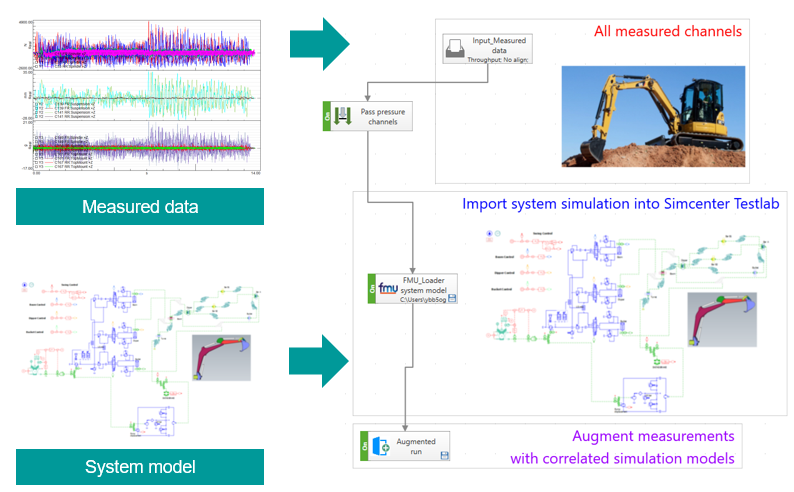
2. Faster and reliable hardware for heavy equipment durability testing
As I also illustrated at the very beginning of this blog, it would be very disappointing to see some system failures during the measurement under extreme conditions. In addition to this, inefficient hardware distribution and long cables leading to costly instrumentation and reduced data quality would also impact test efficiency.
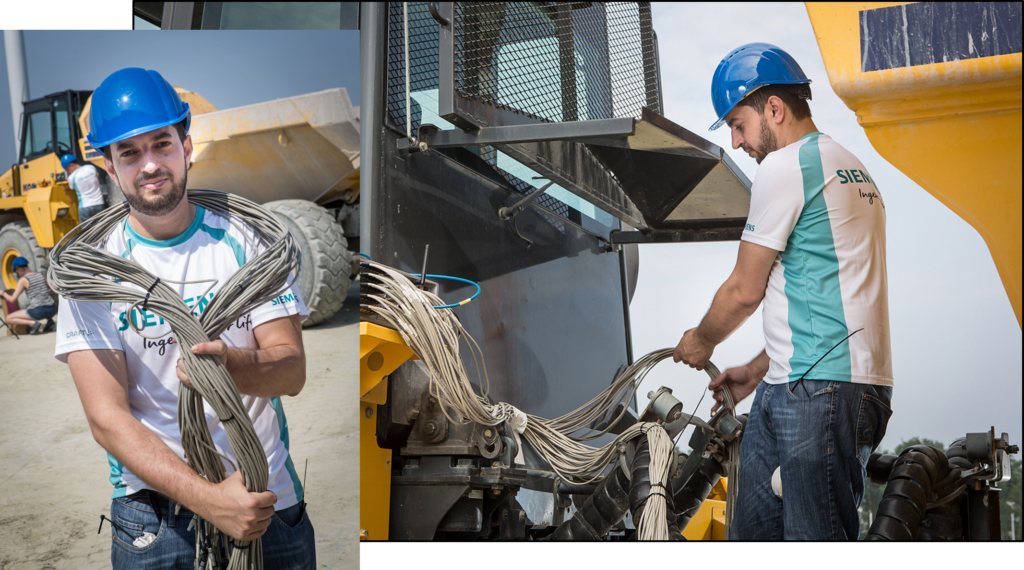
Rugged hardware
One of the design criteria we took for Simcenter SCADAS RS was ruggedness to enable systems to work in extreme environments without failures. So, we tested Simcenter SCADAS RS units against water and dust ingress, high levels of shock and vibration, and a wide range of operating temperatures to certify their ruggedness.
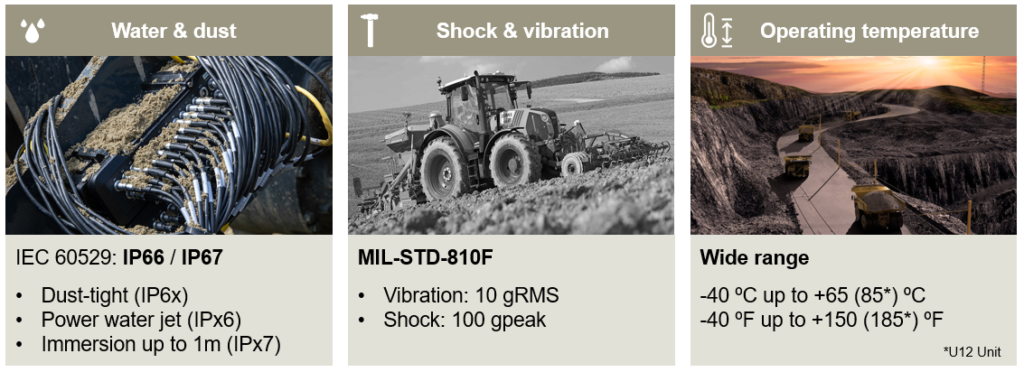
Simplified cabling
Ruggedness was not the only design criteria we considered to make the system efficient enough. As mentioned earlier, we used single digital daisy chain cables in between units for data transfer, data synchronization, and power transfer. There is no need to use external adapters or cables to condition the sensors since Simcenter SCADAS RS units have embedded signal conditioning.
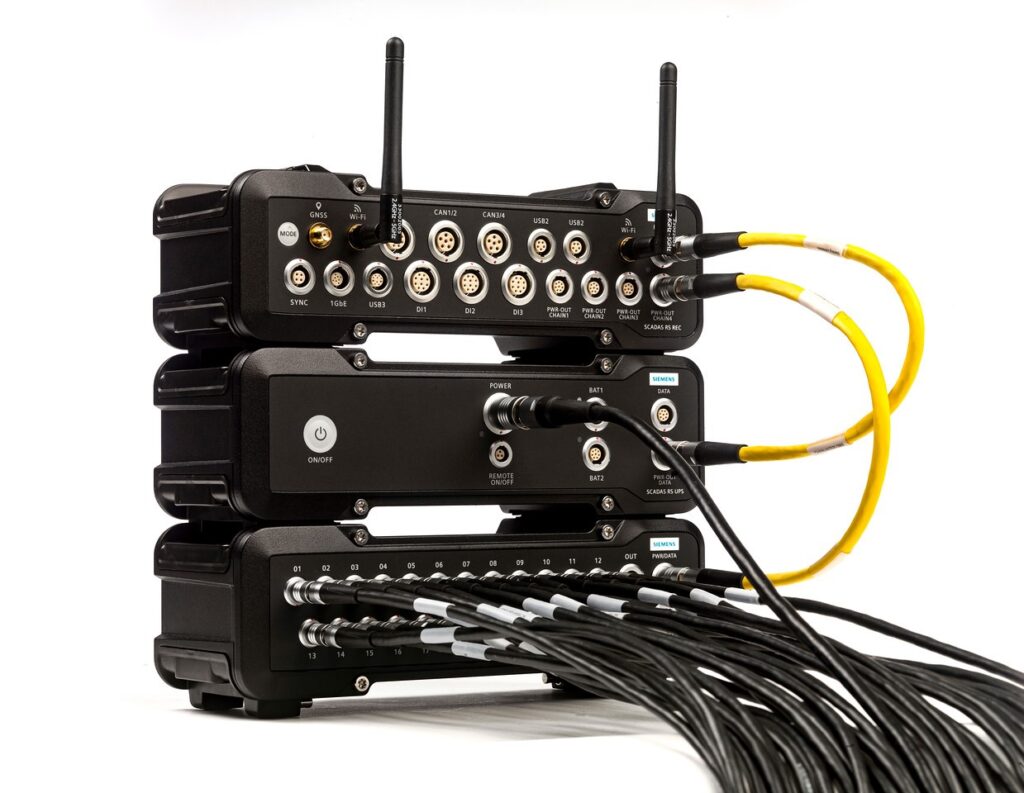
Distributed setup
Since classical centralized hardware setup brings some inefficiencies such as high cable cost, extra weight, time-consuming cable fixation, challenging in-field repair/replace, and electrical interferences, we highly recommend using a ‘distributed setup’. Since all the units are ultra-rugged and extra protected, there should be no hesitation to position them on the outside of the machine.

Above, we see an example of 60 channels configuration both for centralized and distributed setups which already gives some indications about the system efficiency with distributed setup at a first glance.
3. Flexible software operations
Until now, we always mentioned the hardware part in a heavy equipment durability testing campaign. But, there is also a need for software in order to apply channel setup, check signal correctness, control the measurement and validate the acquired data in the context of durability acquisition.
Hardware system access during the measurement
The main challenge is actually related to hardware access during the measurement for validating the data on-the-spot. It’s not always easy for test engineer to sit inside a machine and perform validation during the acquisition. If the test engineer is lucky enough, he can find a place to sit inside the machine. If not, a standalone measurement would lead to a ‘blind measurement’ where the engineer would be forced to check the sensor conditions and data afterward. But the disadvantage for stand-alone measurement is the need for re-test in case of signal failures which will be quite time-consuming.
Considering all the limitations and challenges, we designed our web-based software solution.

All you need for system access!
Simcenter SCADAS RS Recorder App is a web-based service enabling wired and wireless access to Simcenter SCADAS RS. Web-based service grants versatile system access. This means that you can use your PC, tablet, or mobile phone using wired or wireless connection. It’s possible to use the app with any operating system with single or multiple users. It’d be also wise to indicate that multiple user access can also bring some further efficiencies during the instrumentation since multiple users can work in parallel – especially distributed setup would help a lot here.
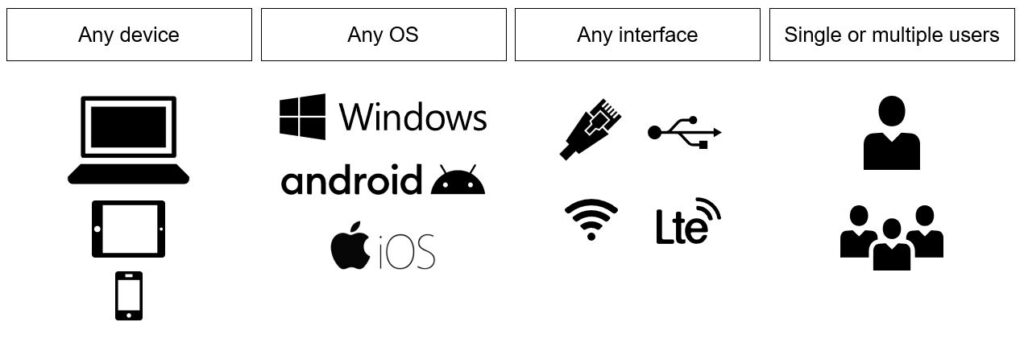
The app, which doesn’t require any license or installation, is applicable for channel setup and verification, sensor calibration, measure, and validation.
There are multiple different displays enabling users to detect sensor or instrumentation problems when they occur. Beyond the capabilities enabling pre-checks, there are even some dedicated displays that help validate the data on the spot. Let’s see all those in the following videos.
Unattended acquisition and remote monitoring
We can also benefit from another Siemens solution, SCALANCE M, which enables mobile network. And I should also indicate that Simcenter SCADAS RS hardware is able to work with such modem to stream data remotely to a server – this is quite important for remote data acquisition!
SCALANCE M needs to have a SIM card installed from a public network provider. SCALANCE M modem connected to Simcenter SCADAS RS can be an option here with a limited security, since we can rely on the password credential of Simcenter SCADAS RS and an additional VPN established for SCALANCE M. But you can also rely on another Siemens solution, SINEMA RC server, which is designed to manage platform for remote networks. SINEMA RC provides encrypted connections with VPN, and it’s possible to control all VPN connections from the server side, which grants a safe and secured environment.
After having proper connection, you’d also be able to use Simcenter SCADAS RS Recorder App from thousands of kilometers away as same as you’re next to the system! Then it will be a simple work to monitor measurements and even download into your own PC to perform more advanced load data analysis.
4. Innovative load data analysis
After having data completely acquired, we, test engineers, still need to perform quite some activities on the software side in order to better consolidate and classify the data. This is mainly an activity to perform in the office environment since it requires attention.
Durability is an attribute where we need to consolidate a large amount of measured data and better understand the acquired field loads by their durability potential due to the fact that durability life expectation from the customer is always high. Besides this challenge, test engineers mostly need to convert and upload data into another tool to process data for durability – considering that data acquisition systems and data processing tools are from different vendors.
Damage-based comparisons
Suppose you would like to compare the following 2 measurements. You have collected time data on 2 different field conditions (Field A and Field B) and would like to understand which road surface now has introduced the most damage to your agricultural machinery. As you also guess, it’s not very easy to compare such loads on the time domain.

The only way to understand which measurement/field is more damaging than the other is by calculating the damage potential of each of these measurements/fields. With the Simcenter Testlab Software – which might already be used on your acquisition works (so, no data conversion needed) – it is very simple to conduct an in-depth load data analysis to have better understanding of applied loads from a durability point of view. Let’s check in the next video how you can easily conduct durability load analysis with Simcenter Testlab.
5. Build accelerated test scenarios to improve your heavy equipment durability testing approach
After understanding the durability potential from acquired loads, test engineers still need to identify some accelerated test scenarios which would serve as an input for test benches or for virtual validation.
As mentioned earlier, durability measurements are mostly performed with very long durations. These long measurements are then extrapolated to durability lifetime which makes it even longer.
Take the example of construction machinery and assume that life expectation for such a machine is 50k operating hours. And if you want to perform a real-life equivalent test in the lab for a specific component, it will take 5.7 years in the best case – 7/24 non-stop test. This would not be a sustainable scenario assuming that manufacturers are already looking for productive ways to reduce their time-to-market.
How to create accelerated and damage-equivalent scenarios?
We really need to create some condensed test scenarios which ideally need to be damage-equivalent with the real-life scenarios for specific components or the whole machine. But, how can we accelerate time signals?
A little bit of background first…
The left-hand side plot below shows a range-pair diagram of a loading time series in a cumulative damage view. The total applied damage of this particular loading is 6 promille. When you take a closer look, then you will see that all loading cycles below 4000N only contribute less than 0.5% of the total damage. If we now express the same range pair diagram in cumulative cycle count, then we see that (if we remove all these cycles with an amplitude lower than 4000N and only keep the high-amplitude cycles) the total number of cycles goes from 1000 to 70. By proceeding this way you can reduce the total time-length of the loading by more than a factor of 14, and still, keep almost the same damage.
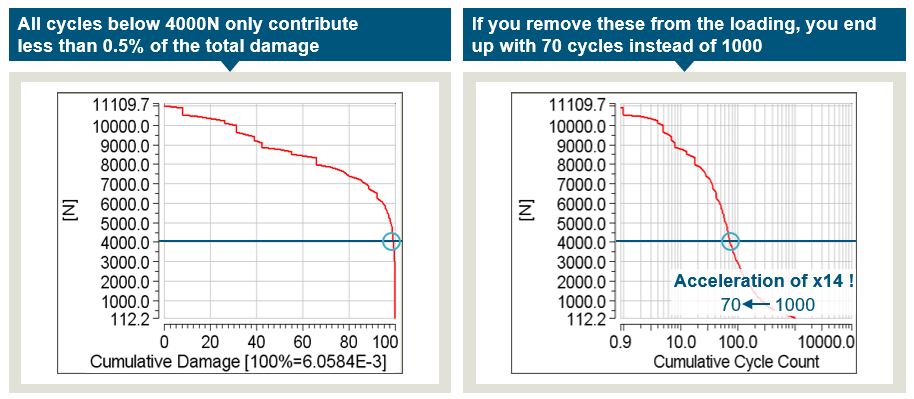
The previous example was for a loading in only one direction (uni-axial). Most measurements however, undergo loads in different directions (multi-axial), for example a load in the vertical, lateral and longitudinal direction. In that case, the time series – and alternating loads – will differ from each other. Doing an uni-axial rainflow filtering channel-per-channel, in that case, is not OK. When you remove parts of the time signal for each channel separately, then you also remove the phase information/time relationship between those different channels. Therefore, in the case of multi-axial loadings, it is important to take this phase relation with the other directions/channels into account. This is done in the so-called Rainflow Projection (RP) filtering method.
Simcenter Testlab for accelerated test cycles
Simcenter Testlab software also enables the method of ‘removing non-damaging events’ with an automated way. The user can identify the damage retention (in percentage) he/she desires and compare the original and compressed signal by the end of the process. The next video shows how Simcenter Testlab removes non-damaging events.
Conclusion
In this article, I tried to mention the nice features of Simcenter SCADAS RS hardware, Simcenter SCADAS RS Recorder App, and Simcenter Testlab software. All can help you tackle your daily testing challenges by boosting your test productivity for several different activities.
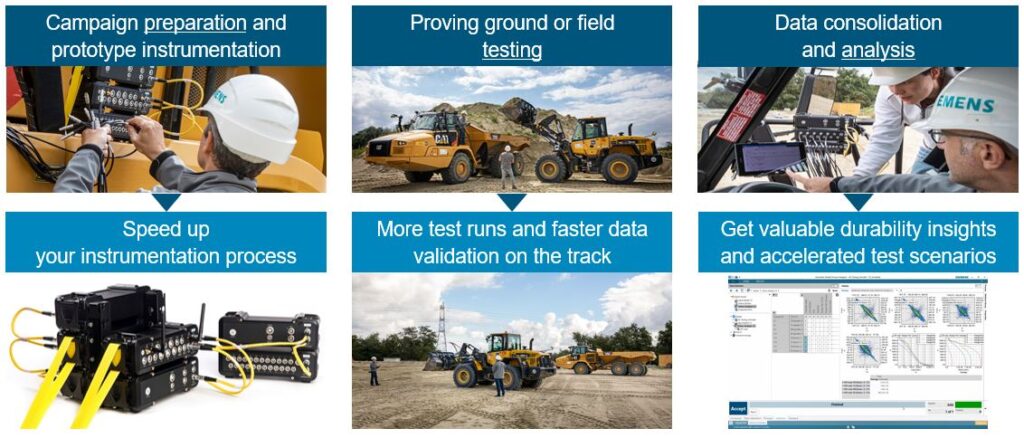
Do you face different challenges? Let’s keep in touch! Please feel free to comment under this post or you can directly contact me via e-mail – safak.has@siemens.com.


